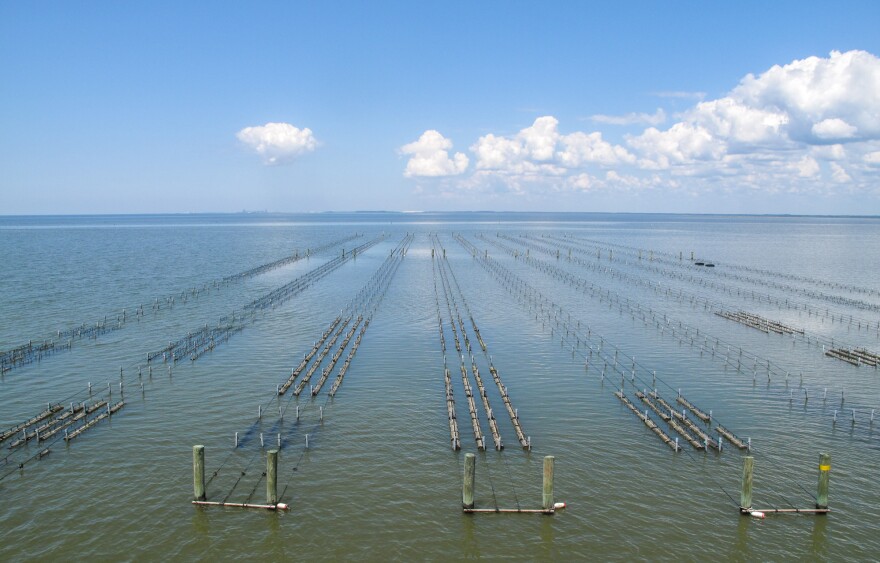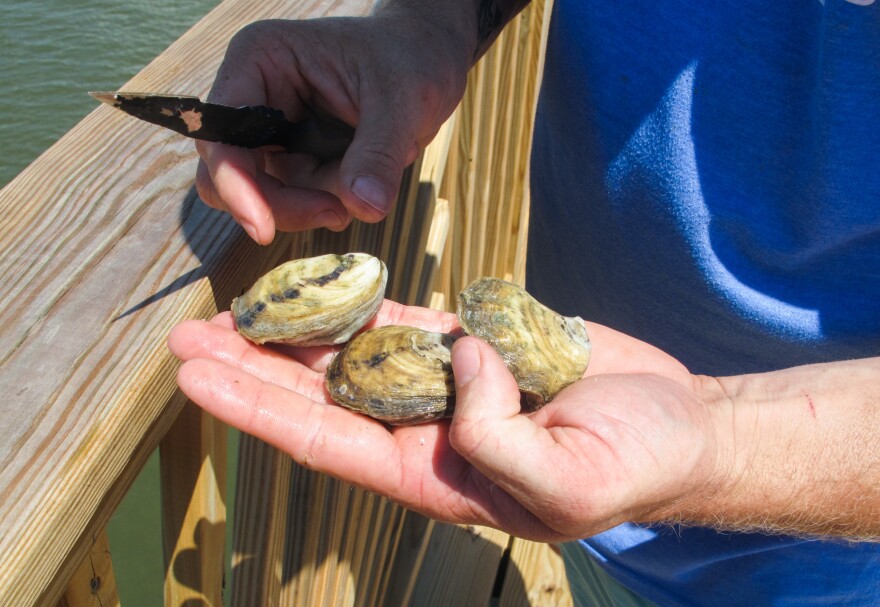Eight miles down a dirt road through the swamps of southwest Alabama, Lane Zirlott has 1.8 million oysters in the water at his family's farm in Sandy Bay.
"What we've been doing is trying to redefine what people are thinking of a Southern gulf oyster," Zirlott says.
The Murder Point oyster farm covers about two and half acres in the bay. The name changed from "Myrtle Point" in 1929, after a deadly dispute over oyster territory.
"Two men got in an argument over rights to a lease. One guy come back that afternoon and killed the other guy. And so from that time forward they called it Murder Point," Zirlott says. "So we kind of adopted the name and put it with the tag line 'oysters worth killing for.'"
There are 10 long rows of wood piling and PVC piping. Oblong oyster baskets hang from lines strung between them.

Zirlott explains that this is called the Australian long line system. "We have the oysters hanging in line with the line that's running down pipes," he says.
Wave action tumbles the oyster baskets, which can be positioned up and down the water column, and pulled out to dry so barnacles won't attach.
If it's a calm day, like this one, farmers wade into the chest-deep water to manually shake the oyster baskets.
Zirlott says that action is key. It knocks the edges off the shell, keeping it more compact and forcing the oyster inside to grow deep and plump, instead of wide and flat.
"We found that the petite oyster was the way to go," he says. "Deep cupped. Two-and-a-half, three inches max. Perfect little one-shot oyster."
All of Zirlott's oysters are destined for the premium half-shell market – showing up on raw bar menus alongside more well-known farmed oysters from the East and West coasts. His clients include trendy spots in Houston and New Orleans.

The Gulf oyster industry suffered a blow during the 2010 BP oil spill. And while wild oyster harvesting from reefs is back in business, the industry is still not up to pre-spill levels.
Off-bottom farming, in which the oysters rest in floating aquaculture cages instead of on the muddy bottom, has taken off since. There were no oyster farms in the Gulf of Mexico in 2009. Now there are dozens from Louisiana to Florida, according to Auburn University marine scientist Bill Walton. He's also known as "Dr. Oyster" because he spawns oysters at the Dauphin Island Sea Lab on the Alabama coast.
Walton pours a bucket of larvae into a big blue tank.
"The fertilized egg that we put into this tank, within a day it's a swimming larva that actually has to eat, and it's swimming around and has got a stomach," Walton says. "I mean it's a critter."
The hatchery produces oyster seed to sell to farmers. Louisiana State University has a similar program.
Walton says the industry is still young and vulnerable to the same threats and forces of nature that wild oysters face. Last year a harmful algal bloom shut down harvesting.

But he's hopeful it can be an option for people looking to make a living on the coast.
"Even in 2008, 2009 you had people before the oil spill who weren't sure," he says. "Do you tell your teenage son or daughter to go into shrimping? But you don't want to move away and you don't want to leave your family, so how do you ... stay living in your community working on the water?"
For Zirlott, a 5th generation commercial fisherman, oyster farming was a way back home.
"We shrimp from the Texas-Mexican border as far as Virginia at times. And so you had to be gone," he says.
But after his two children were born, he wanted a change.
"It was time for me to be home," says Zirlott. "But what to do?"
His mother took an aquaculture class and got the family to try oyster farming about 3 years ago. Now Murder Point is looking to double in size and open its own hatchery. Zirlott says he's encouraging his children to get degrees in biology.

"I'm looking to keep a tradition alive but by new modern ways to do it," he says.
He touts Murder Points as the ultimate farm-to-table food, and uses social media to market with the hashtag #Butterlove. That's for the flavor.
"When you get past the salt ... you start to get a rich buttery aftertaste," says Zirlott.
Celebrity Chef Emeril Lagasse's Instagram recently featured a shot of an iced-down platter of raw oysters he was having at Fisher's Restaurant in Orange Beach, Ala. They were Murder Points.
Copyright 2021 NPR. To see more, visit https://www.npr.org.







